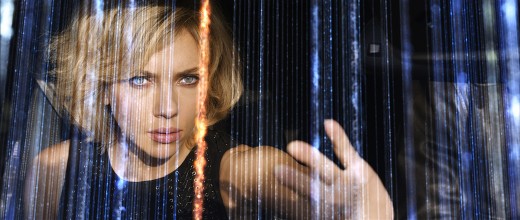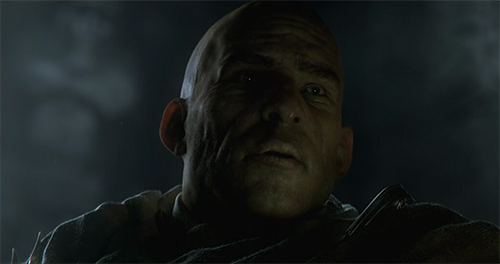 I’m going to lay it out here: Lucy is a terrible fucking movie. It barely has merit as a film at all. It’s much like Scarlett Johansson‘s eponymous character in the movie: cool to look at but very little substance beyond that.
I’m going to lay it out here: Lucy is a terrible fucking movie. It barely has merit as a film at all. It’s much like Scarlett Johansson‘s eponymous character in the movie: cool to look at but very little substance beyond that.
I chose to watch this because I like to punish myself.
The general conceit of the movie is that Lucy, through some vague machination of a man she’s been dating a week, is forced into being a drug mule for Korean drug lord (Choi Min-sik) in Taiwan. While in captivity, the bag holding the drugs that have been sewn into her organs is busted open and she suddenly gains the ability to use more than 10% of her brain. The rest of the movie is the even more improbable events of her trying to reconcile with this fact and seek revenge on the organization that put her in this state, along with a professor (Morgan Freeman) and a french detective (Amr Waked.)
Movies have been playing around with the idea of drugs that somehow give us superhuman mental abilities (like Limitless) but have done a way better job of maintaining believability; this movie harps visually on Lucy’s numeric brain potential rising over the course of the story and it’s ridiculous. The idea that we only use 10% of our brain’s “potential” is trash science (imagine if you didn’t have access to the 10% that controls autonomic functions) but the ultimate conclusion that we’d be able to access X-Men level powers of telepathy and time-control just sort of spirals out from there. It doesn’t even try to make the movie logically consistent, and I consider myself willing to swallow quite a lot of science-fiction (except that the Flash can move faster than the speed of light.)
Narratively, the movie is cob-web thin. Both plot and dialogue are insubstantial and wholly unbelievable. Lucy moves from location to location, beating up people, using her powers inconsistently as she grows more and more into a supercomputer of terrifying proportions. No, I am not even being metaphorical on this count: she literally turns into a giant oozing black supercomputer, Akira-style, and then dissipates into the electronic ether. (My head-canon for this is that she eventually transforms into the voice-activated AI from Her, in a cruel twist of fate.) Characterization is also in short supply, as well. Characters are no more than talking heads or action-doers, simple organisms that shoot or throw out lines. The only characters who seem to merit names or individual personalities are Professor Norman (who provides the flimsy scientific plot hooks and awed expressions), Pierre del Rio, Mr. Jang and that’s it. It would be clever to say that they are merely obstacles to Lucy’s ascension into a pure being but that would imply a level of depth that is not found here.
Lucy’s characterization is similarly shallow but in a more problematic way: I noticed that the larger her brain capacity grew, her humanity fell away. I know this is intentional, as several times through the film they make a point of her remarking that human beings and their “lower” brain capacity are ruled by base desires and fear. It is a really gross and fairly ableist view of intellect and emotion, positing that rationality and pure knowledge rule out over feelings or that people with more brainy pursuits are somehow a higher echelon of human being. It comes across to me as a more artistic interpretation of gendered views on reason, that rationality is better and emotionality is not. Lucy moves from the beginning of the film where we are given nothing but a scared lady wearing typical club gear, scared out of her wits, to being transformed into a robotic, and even god-like (there’s an actual scene where she touches a primate ancestor’s finger in the exact method of Michaelangelo’s famous Sistine Chapel painting, I shit you not) being that is “so much better” then her former self. This leads into where I felt the real problems of the film were from a feminist perspective.
When the movie’s marketing engine first cranked up, there were some initial salvos that this was the “feminist film” we had all been waiting for, with a particularly bad-ass Johansson wending her way through Taiwan with a flurry of gunshots and kicks. Feminist it is not, not in the slightest. Not only is Lucy’s transformation presented in a very flat, unappealing “strong female character” way that relies entirely on masculine traits of violence and stoicism, but there is nothing feminist about the staggering amounts of racialized violence that occur in this movie. All of the aggressors in the movie are portrayed as some combination of Asian gangster stereotypes without acknowledging that one of the biggest aggressors in the movie is Lucy herself. I guess a white woman shooting down several Taiwanese people (one of whom is merely on a surgical table at the wrong time) is totally “kick-ass”? I was not really seeing how this was some feminist triumph when Lucy is basically a white female version of a thoughtless white male action hero with even less concern for human life.
It was not surprising to me that this movie was written and directed by Luc Besson. Besson has a pretty solid body of work that features complicated women characters like Nikita, The Messenger, and my favorite The Fifth Element. This movie felt weighed down by a huge CGI budget, confusing visuals and a really shoddy script. It felt like the typical Besson “girl” on the surface but the rest is phoned in, offensively so. In other films, particularly Fifth Element, the woman’s “chosen one” status is played artfully or at least in a clever way; Lucy is just incredibly hamfisted and empty.
Overall, I’d say that this movie was disappointment, but that would imply that I had high expectations going in.


